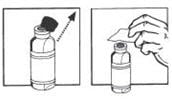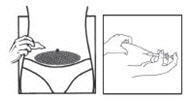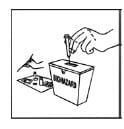What is Cetrotide?
Cetrotide blocks the effects of a natural hormone, called gonadotropin-releasing hormone (GnRH). GnRH controls the secretion of another hormone, called luteinizing hormone (LH), which induces ovulation during the menstrual cycle. During hormone treatment for ovarian stimulation, premature ovulation may lead to eggs that are not suitable for fertilization. Cetrotide blocks such undesirable premature ovulation.
Cetrotide is used to prevent premature ovulation during controlled ovarian stimulation.
Who should not use Cetrotide?
Do not use Cetrotide if you
- have kidney disease
- are allergic to cetrorelix acetate, mannitol or exogenous peptide hormones (medicines similar to Cetrotide) or
- are pregnant, or think that you might be pregnant, or if you are breast-feeding.
Consult your doctor before taking Cetrotide if you have had severe allergic reactions.
How should I use Cetrotide?
Ovarian stimulation therapy is started on cycle Day 2 or 3. Cetrotide 0.25 mg is injected under the skin once daily, as directed by your physician. When an ultrasound examination shows that you are ready, another drug (hCG) is injected to induce ovulation.
You may self-inject Cetrotide after special instruction from your doctor.
To fully benefit from Cetrotide, please read carefully and follow the instructions that come with Cetrotide, unless your doctor advises you otherwise.
Cetrotide is for injection under the skin of the lower abdominal area, preferably around, but staying at least one inch away from the belly button. Choose a different injection site each day to minimize local irritation.
Dissolve Cetrotide powder only with the water contained in the pre-filled syringe. Do not use a Cetrotide solution if it contains particles or if it is not clear.
Before you inject Cetrotide yourself, please read the instructions for use that come with Cetrotide.
Directions for using Cetrotide 0.25 mg with the enclosed needles and pre-filled syringe:
| 1. Wash your hands thoroughly with soap and water. |  |
| 2. On a clean flat surface, lay out everything you need (one vial of powder, one pre-filled syringe, one injection needle with a yellow mark, and one injection needle with a grey mark). |  |
| 3. Flip off the plastic cover of the vial. Wipe the aluminum ring and the rubber stopper with an alcohol swab. |  |
| 4. Take the injection needle with the yellow mark and remove the wrapping. Take the pre-filled syringe and remove the cover. Twist the needle on the syringe and remove the cover of the needle. |  |
| 5. Push the needle through the center of the rubber stopper of the vial. Inject the water into the vial by slowly pushing down on the plunger of the syringe. |  |
| 6. Leave the syringe in the vial. While carefully holding the syringe and vial, swirl gently to mix the powder and water together. When it is mixed, it will look clear and have no particles in it. Do not shake or you will create bubbles in your medicine. |  |
| 7. Draw the total contents of the vial into the syringe. If liquid is left in the vial, invert the vial, pull back the needle until the opening of the needle is just inside the stopper. If you look from the side through the gap in the stopper, you can control the movement of the needle and the liquid. It is important to withdraw the entire contents of the vial. |  |
| 8. Detach the syringe from the needle and lay down the syringe. Take the injection needle with the grey mark and remove its wrapping. Twist the needle on the syringe and remove the cover of the needle. |  |
| 9. Invert the syringe and push the plunger until all air bubbles have been pushed out. Do not touch the needle or allow the needle to touch any surface. |  |
| 10. Choose an injection site in the lower abdominal area, preferably around, but at least one inch away from the belly button. Choose a different injection site each day to minimize local irritation. Take a second alcohol swab and clean the skin at the injection site and allow alcohol to dry. Inject the prescribed dose as directed by your doctor, nurse or pharmacist. |  |
|
11. Use the syringe and needles only once. Dispose of the syringe and needles immediately after use (put the covers on the needles to avoid injury). A medical waste container should be used for disposal. |
 |
What do you do if you have used too much Cetrotide?
Contact your doctor in case of overdosage immediately to check whether an adjustment of the further ovarian stimulation procedure is required.
What are the possible side effects of Cetrotide?
Mild and short lasting reactions may occur at the injection site like reddening, itching, and swelling. Nausea and headache have also been reported.
Call your doctor if you have any side effect not mentioned in this leaflet or if you are unsure about the effect of this medicine.
General information about the safe and effective use of Cetrotide
This leaflet provides a summary of the information about Cetrotide. Medicines are sometimes prescribed for uses other than those listed in the Leaflet. If you have any questions or concerns, or want more information about Cetrotide, contact your doctor or pharmacist.
How should I store Cetrotide?
Store Cetrotide in a cool dry place protected from excess moisture and heat.
Store Cetrotide 0.25 mg in the refrigerator at 2-8°C (36-46°F). Keep the packaged tray in the outer carton in order to protect it from light.
How long may Cetrotide be stored?
Do not use the Cetrotide powder or the pre-filled syringe after the expiration date, which is printed on the labels and on the carton, and dispose of the vial and the syringe properly.
How long can you keep Cetrotide after preparation of the solution?
The solution should be used immediately after preparation.
Store the medicine out of the reach of children.
If you suspect that you may have taken more than the prescribed dose of this medicine, contact your doctor immediately. This medicine was prescribed for your particular condition. Do not use it for another condition or give the drug to others.
What are the ingredients in Cetrotide?
Active ingredient: cetrorelix acetate
Inactive ingredient: mannitol, sterile water for injection




